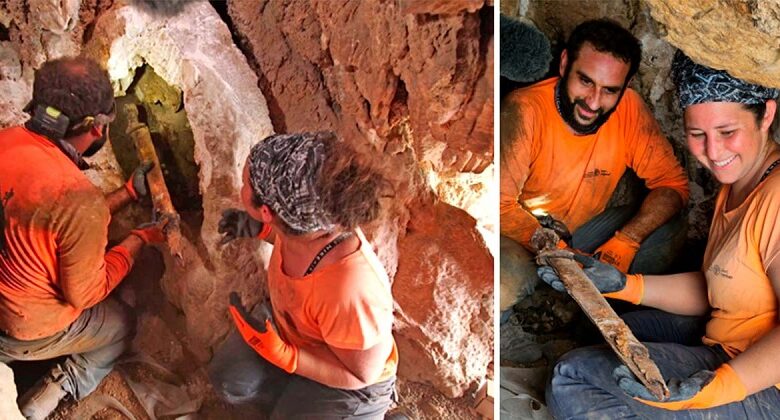Archaeological Marvel: Cache of Ancient Roman Swords Unearthed in Israel’s Judean Desert

Archaeologists have made an astounding discovery in the Judean Desert, revealing a cache of ancient Roman swords concealed within a small cave. The remarkable find sheds light on a tumultuous period in history when the swords may have been hidden by Judean rebels during the Jewish–Roman wars, which spanned from AD 66 to 136.
The revelation came to light during an investigation of a well-known Hebrew script inscription within a cave situated in the En Gedi Nature Reserve, Israel, conducted by the Israel Antiquities Authority (IAA). While exploring the upper reaches of the cave, Asaf Gayer from the Hebrew University of Jerusalem came across an extraordinarily well-preserved Roman pilum, a type of javelin, securely nestled within a deep, narrow crevice. Nearby, pieces of crafted wood were found in a separate niche, eventually identified as parts of the swords’ scabbards.
The IAA was promptly notified, and a subsequent archaeological effort led to the recovery of four remarkably well-preserved swords that date back approximately 1,900 years to the Roman period. These swords are believed to have been hidden away by Judean rebels, likely as spoils of war, during the tumultuous Jewish–Roman wars that had devastating consequences for the Jewish community, eventually leading to their dispersion and oppression.
Due to the unique conditions within the cave, these ancient swords have remained exceptionally well-preserved, with three of them still bearing their wooden scabbards attached to the iron blades. These three Roman spatha swords measure between 60 and 65 centimeters in length and were commonly used by the Romans from the 1st to the 6th century AD. The fourth sword, slightly shorter in length, is identified as a ring-pommel sword.
Dr. Eitan Klein, one of the directors of the Judean Desert Survey Project, explains the significance of this discovery, stating, “The hiding of the swords and the pilum in deep cracks in the isolated cave north of ‘En Gedi hints that the weapons were taken as booty from Roman soldiers or from the battlefield, and purposely hidden by the Judean rebels for reuse.” Clearly, the rebels were keen to avoid being apprehended by Roman authorities while in possession of these weapons.
Klein further adds, “We are just beginning the research on the cave and the weapon cache discovered in it, aiming to try to find out who owned the swords, and where, when, and by whom they were manufactured. We will try to pinpoint the historical event that led to the caching of these weapons in the cave and determine whether it was at the time of the Bar Kokhba Revolt in AD 132–135.”
The archaeological find not only provides valuable insights into the historical context of the Jewish–Roman wars but also adds another layer of understanding to the lives and struggles of the Judean rebels during this tumultuous period. The swords’ exceptional preservation within the cave serves as a testament to the resilience of archaeological artifacts and their ability to tell stories that bridge the gap between ancient and modern times. This discovery is a testament to the enduring fascination of history and the invaluable contributions of archaeology in uncovering the mysteries of the past.
News Mania Desk / Agnibeena Ghosh 8th September 2023






